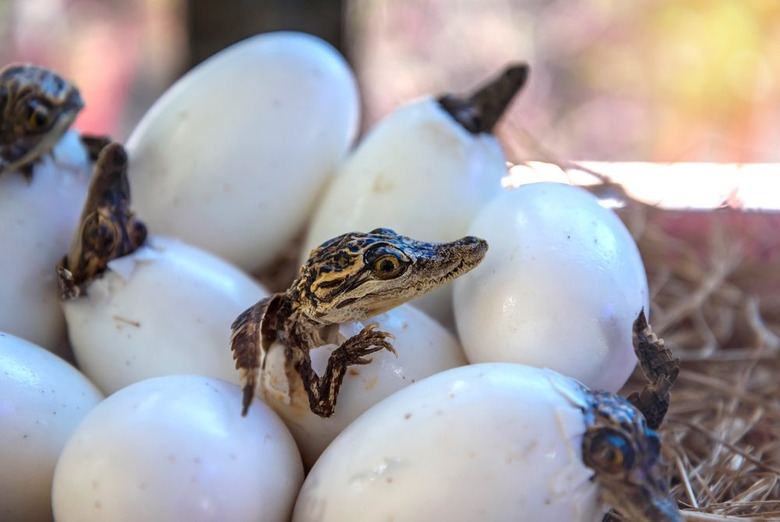6 Animal Eggs You Won't Believe They Eat In Other Countries
It's probably somewhat closeminded that in America that the term "eggs" refers to chicken eggs about 99.99 percent of the time. Sure, some people occasionally eat other types of bird eggs (quail, pheasant, duck, etc.) or caviar from time to time (usually after finding a big pile of money), but chickens totally have a monopoly on the word "egg."
Elsewhere in the world, things are a bit different. The range of egg options is a lot wider, due to both accessibility and the general willingness to eat foods that might appear a bit too funky for most Americans. In fact, there are some egg types that people in the U-S-of-A are blissfully unaware of altogether. They might know those animals lay eggs, but would never give thought to actually consuming the potential offspring, or refuse to believe the fact when informed. But, like Neil deGrasse Tyson once said about science: "It's true whether or not you believe in it." With that, let's explore some of the truly bizarre animal eggs that it might shock you to find out people actually eat in other countries.
Ant
They might look like little grains of rice, but these small white ovals are actually ant eggs — or, more accurately, ant larvae. And you don't need to go very far to get them either (I'm sure you're very relieved at this fact), as this has been a popular ingredient in Mexican dishes for thousands of years. Also called "insect caviar" or escamol when south of the border, this dish has a slightly nutty and buttery flavor (especially when cooked in butter), and can become crunchy when fried. The escamoles are then added to tacos, omelettes, or even eaten by themselves.
For a unique spin on a traditional Mexican dish, try this salsa recipe made with escamoles.
Balut
Duck and chicken? Great! Eggs? Great! Fertilized duck and chicken eggs? Nauseating. This dish, also known as balut, is incredibly popular in Southeast Asia, but the taste, texture, and general idea make this one tough to swallow — just ask Karl Pilkington, who was famously disgusted by the dish on An Idiot Abroad. The length of incubation before cooking varies based on preference (generally two to three weeks), but once they reach the desired fertilization point, the eggs are boiled and steamed, and then eaten directly from the shell. Although the partially-developed bones are soft enough to chew and swallow, the clearly-recognizable features of the baby animals cause many foreigners to flee — fast.
Brave enough to try balut? Or maybe just curious about the seasonings? Click here for a recipe.
Crocodile
When an animal lays as many eggs as crocodiles do, it's no wonder people eventually decide to try eating them. Apparently the taste isn't very pleasant (they have been described as "strong" and "fishy"), but that doesn't stop locals in Southeast Asia, Australia, and even Jamaica from chowing down on the regular — or at least when they're available. One would think finding and successfully securing these eggs would be difficult (not to mention dangerous), but they are apparently so plentiful in parts of Asia that crocodile egg eating contests are held in some places. Please just do us a favor and don't try to gather the eggs yourself.
Gull
Most people who have visited beaches know seagulls as sneaky and relentless little takers of food — but in some parts of the world, seagulls are also sources of food. By "some parts of the world," we're not even talking about exotic third-world countries though — gull eggs are actually considered a delicacy in England! They obtained this status for a few reasons: First, only a few licensed "eggers" operate in the whole country, and they keep their nesting sites secret. Second, the season of the black-headed gull (from which the eggs, which are white with black spots, come) is extremely short, just lasting about three weeks. And third, the collecting of the eggs is highly regulated, with each egger only permitted to take a single egg from each nest. If a gatherer arrives at a nest and finds it filled with eggs with penciled X-markings on them, it means an egg has already been removed by someone else. After all this, the eggs end up costing around ₤5 ($7.24) each.
As for the preparation, gull eggs are generally boiled for three to four minutes, or steamed for six minutes and immediately dropped into cold water. Click here for more prep info and a simple recipe.
Octopus
The octopus is known in the animal kingdom as being especially protective of its eggs, often guarding them for several years. In fact, it has been documented in nature that an octopus would rather starve to death than leave its eggs alone. Yet we humans are a crafty sort, so of course we found a way to obtain them anyway. Octopus roe is especially popular (albeit expensive) in Japan, where it is incorporated into sushi. In nature, however, the eggs look like small, semi-translucent, white teardrops with visible darker specks on the inside. As they mature, you can clearly see a baby octopus inside if examined close enough.
Snail
As if the idea of eating snail isn't off-putting enough for some people, try offering them snail eggs. That's right, snail/escargot caviar is actually a thing in some places — and not just any old thing, but the new "it" delicacy in Europe, specifically France and Italy. Tiny, snowy white, and glistening in appearance, it takes snails eight months to produce these eggs with accelerated maturing techniques (two to three years without), and a small, 50-gram jar can cost almost $100. Out of everything on this list, escargot caviar might be the only one that you'll likely hear more about in the coming months and years.
